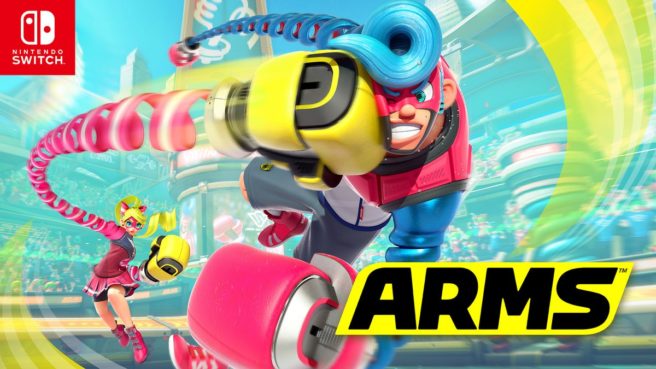Arms producer on the game’s origins, more news about content to come, controls, more
Famitsu continued its extensive Switch coverage this week by publishing an interview with Kosuke Yabuki, the producer of Arms. This is the first time we’re really able to hear from Yabuki about the game in-depth since its reveal at the Nintendo Switch Presentation 2017.
Yabuki explained to Famitsu how Arms came to be, talking about how it emerged as one of Nintendo’s various prototypes and wanting to try something new in the fighting genre. He also teased more content news to come (including characters, arms, and modes), touched on the controls, and more.
We’ve posted our translation of the interview in full below.
Arms was announced at the presentation. How did its development come about?
Nintendo is always coming up with various prototypes for games, and we were involved in that process where ideas go on to become new games. Out of these numerous prototypes, we chose one that would fit well alongside the Switch’s launch, and it became the basis for Arms.
I’m assuming that these prototypes are created to test very basic gameplay concepts. So, what kind of concept did Arms originate as? I would imagine it started as a boxing game where the characters’ arms would stretch out…
No, it was not originally a concept for a boxing game. There are many fighting games, like Street Fighter or Super Smash Bros., or even “3D fighters” like Tekken, where the game is viewed side-on. Since the beginning of fighting games, the side view has been the mainstream, but I’ve always thought, why couldn’t we do it a little differently? However, it can be difficult to gauge depth in games where the camera is behind you. So I was absolutely convinced that it would not be suited for fighting games, which require precise distance control. But the fact that your arms extend, and that it takes a bit of time for them to impact, makes it quite likely your attacks will succeed. My idea was to have the game’s tactics revolve less around whether your attack would hit or not, and more around the timing and delay between your attacks connecting. So in pursuing a new kind of fighting game where the camera is behind you and your arms extend, Arms was born.
When playing, it almost feels as though there’s a shooting mechanic in the game.
They’re punches, but there is an aspect of them that’s similar to missiles, which you’re aiming and looking for a chance to fire.
Honestly speaking, when I first saw the game, I thought it would be like the boxing in Wii Sports, where you’re engaging in very exaggerated punching motions. But, even though you can play Arms like that, if you become skilled enough, you can also evade your opponent’s attacks perfectly, and predict their movements to land your own attacks. So if you put some effort into playing, you’ll be able to enjoy that sort of strategical gameplay.
We had no reason to create another Wii Sports. As someone who worked on Mario Kart, I’m always coming up with ideas to spice up the gameplay by adding unrealistic movements and gimmicks.
At this event, there are five characters available, each with three different types of arms. Will there be more characters in the retail version?
There will be more characters, with more arm types. What we have available today is just a portion of what will be available in the full game. You can look forward to more information gradually coming out as the release date approaches.
I see. And the five characters available here can be divided into the Balanced type, Power type, and Speed type, correct?
That’s right. Everyone has unique basic actions available to them, and stats such as movement speed and the amount of damage they inflict are also dependent on the character.
Surely some are more effective in certain matchups?
Of course. Not only the character, but the type of arms they have equipped as well.
A character can reverse their weaknesses and strengths depending on their arm choice, so players can balance them out.
For example, the Power-type Master Mummy has heavy attacks that can deflect almost any attacks thrown at himself. But if his opponent chose something like the Boomerang Arm, they could bypass his deflection by going around it.
I see. It seems like it would be strategically sound to keep at least one arm ready at all times, instead of sending both out to attack at once.
We’ve let all sorts of people play the game, and after spending some time with it, most of them decide “I shouldn’t punch too often”, and wait to react to their opponent’s attacks instead. But once they pass that stage, they do things like manipulate their opponent’s movements with constant attacks or force them into corners. Their strategic capabilities grow more advanced, so there’s a big difference in how people fight depending on their skill.
